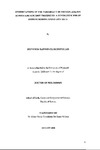UNDERSTANDING OF THE VARIABILITY OF PHYTOPLANKTON ECOSYSTEM FUNCTION PROPERTIES: A SYNERGISTIC USE OF REMOTE SENSING AND IN SITU DATA
| dc.contributor.author | RAITSOS-EXARCHOPOULOS, DIONYSIOS | |
| dc.contributor.other | School of Geography, Earth and Environmental Sciences | en_US |
| dc.date.accessioned | 2013-10-23T11:20:40Z | |
| dc.date.available | 2013-10-23T11:20:40Z | |
| dc.date.issued | 2006 | |
| dc.identifier | NOT AVAILABLE | en_US |
| dc.identifier.uri | http://hdl.handle.net/10026.1/2321 | |
| dc.description.abstract |
The majority of the earth's surface (-71%) is covered by the aquatic environment where 97% of that is the oceanic regime. Almost every part of the aquatic regime is dominated by microscopic plants called phytoplankton. Being at the bottom of the food chain, these ecological drivers influence the earth's climate system as well as the biodiversity trends of other organisms such as zooplankton, fish, sea birds and marine mammals. The aim of this research was to understand the ecology of phytoplankton and assess which environmental, physical, biological, and spatiotemporal factors influence their distribution and abundance. Using this information a knowledge-based expert system discriminated phytoplankton functional types. The ecological knowledge was derived from the Continuous Plankton Recorder (CPR) survey, whereas information regarding the physical regime was acquired from satellite remote sensing. The data matrix was analysed using Generalised Additive Models (GAMs) and Artificial Neural Networks (ANNs). The significant relationships developed by the synergistic use of CPR measure of phytoplankton biomass and satellite chlorophyll a (Chl-a), allowed the production of a >50 years Chl-a dataset in the Northeast Atlantic and North Sea. It was found that the documented mid-80s regime shift corresponded to a 60% increase in Chl-a since 1948; a result of an 80% increase in Chl-a during winter alongside a smaller summer increase. GAMs indicated that the combined effects of high solar radiation, shallow mixed layer depth and increased temperatures explained more than 89% of the coccolithophore variation. The June 1998 bloom, which was associated with high light intensity, unusually high sea-surface temperature (SST) and a very shallow mixed layer, was found to be one of the most extensive ( -1 million km² ) blooms ever recorded. There was a pronounced SST shift in the mid-1990s with a peak in 1998, suggesting that exceptionally large blooms are caused by pronounced environmental conditions and the variability of the physical environment strongly affects the spatial extent of these blooms. Diatom abundance in the epipelagic zone of the Northern North Atlantic was mainly driven by SST. The ANNs indicated that higher SSTs could lead to a rapid decrease in diatom abundance; increased SST can stratify the water column for longer preventing nutrients from being available. Therefore, further increases may be devastating to diatoms but may benefit smaller plankton such as coccolithophores and/or dinoflagellates. Finally, the knowledge gained though the developed methodological approaches was used to identify/discriminate phytoplankton functional groups (diatoms, dinoflagellates, coccolithophores and silicoflagellates) with an accuracy of greater than 70%. The most important information for phytoplankton functional group discrimination was spatiotemporal information, and for the physical environment was SST. Future research aimed at the identification of functional groups from remotely sensed data should include fundamental information on the physical environment as well as spatiotemporal information and not just based on bio-optical measurements. Further development, potential applications and future research are discussed. | en_US |
| dc.description.sponsorship | Sir Alister Hardy Foundation for Ocean Science | en_US |
| dc.language.iso | en | en_US |
| dc.publisher | University of Plymouth | en_US |
| dc.title | UNDERSTANDING OF THE VARIABILITY OF PHYTOPLANKTON ECOSYSTEM FUNCTION PROPERTIES: A SYNERGISTIC USE OF REMOTE SENSING AND IN SITU DATA | en_US |
| dc.type | Thesis | |
| dc.identifier.doi | http://dx.doi.org/10.24382/4967 | |
| dc.identifier.doi | http://dx.doi.org/10.24382/4967 |
Files in this item
This item appears in the following Collection(s)
-
01 Research Theses Main Collection
Research Theses Main


